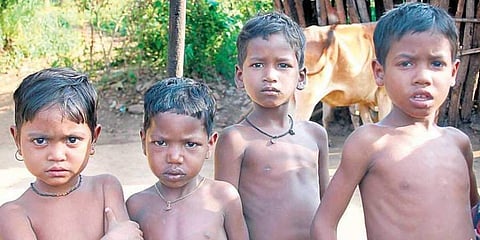

The number of malnourished children at the recently opened rehabilitation centre in Bengaluru suggests that the pandemic and its effects may have worsened hunger and pushed many children across the state into starvation. Twenty-six children aged 0-5 years have been admitted at the Nutritional Rehabilitation Centre (NRC) at Vani Vilas Hospital since it opened in August. Four children were admitted in August, two in September, 16 in October and four in November (till November 17).
But the staff at the centre say the numbers are actually higher as many parents refrain from admitting their children fearing they would contract Covid-19. In October, of the 275 children screened, 24 were diagnosed with Severe Acute Malnutrition and 44 with Moderate Acute Malnutrition. But the parents of only 16 children agreed to admit their kids.
While some children were referred for treatment of other ailments, others were referred by anganwadis. Doctors, anganwadi workers and nutritional experts said while many factors may have led to hunger, the lockdown-induced financial distress and income loss prevented children from accessing nutritious food. “When children come in for diarrhoea, pneumonia, convulsions, sepsis, fever, etc, we detect malnutrition as well. Some cases we have received have been from the anganwadi staff, who spotted malnourished children, especially from Goripalya, Bapuji Nagar, Kumbalgodu, etc in and around Bengaluru.
One of the causes is the financial problem faced by parents due to the pandemic,” said Dr Mallesh K, head of the department of paediatrics at Bangalore Medical College and Research Institute, which has Vani Vilas Hospital under its ambit.
Malnutrition cases found despite ration distribution
Other causes — also pandemic-related — include diversion of healthcare facilities for Covid, lack of access to transport to reach hospitals during the lockdown and reluctance to go to hospitals for check-ups due to fear of contracting Covid. The symptoms that categorise these children as malnourished include insufficient mid-upper arm circumference, wasting which refers to low weight to height ratio, pitting edema which refers to swelling of the leg, visible wasting which includes lack of fat in the body, prominent appearance of bones, looking emaciated, fragile and stunting which refers to less height for age.
Yamuna, who works at an anganwadi in Karwar, Uttara Kannada, said that despite anganwadis distributing dry ration throughout the lockdown and pandemic to children, they are observing cases of malnutrition among children whose parents are poor daily-wage workers who have suffered financially due to the pandemic.
Children of such parents do not have enough nutritious food at home, she added. Dr Antony K R, paediatrician and public health consultant from Kochi, who was the former director of State Health Resource Centre in Chhattisgarh, said that cases of malnutrition were present even before the pandemic hit, but the loss of regular income and income opportunities due to Covid among the poor and downtrodden has aggravated malnutrition among children. However, there have been no quantifiable studies done yet to establish the correlation. “The long-term impact of malnutrition in children includes stunting, poor muscle mass and low body mass index, reduced capacity to withstand infections leading to recurrent upper respiratory infections, aggravated chronic malaria infect ion among tribal and forest-dwellers, etc,” said Dr Antony, who was also the former health and nutrition specialist for UNICEF in India.
He said a healthy person will have the capacity to tide over tuberculosis, but the disease will be worse in a malnourished child. Such kids are poor learners, are slower and less active. Their mental and physical development is impaired, impacting their scholastic performance. Lower iron levels that trigger anaemia also affect their academic performance and make children dull, he said.
